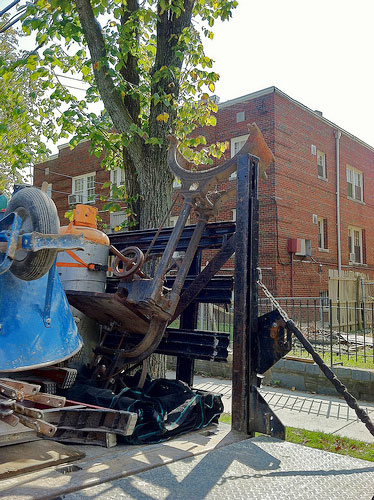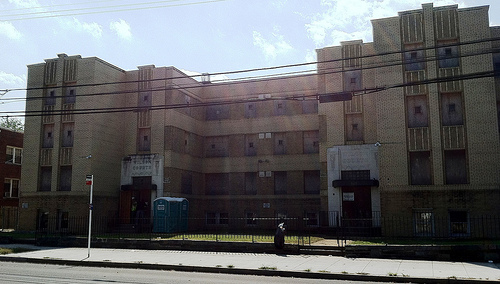Vacant Congress Heights building holds relics of the past
“Look at that thing! That’s an antique!” says William Alston-El as two workers in yellow vests and hard hats emerge from the long-vacant Wilson Courts in Congress Heights. The men carry an aged band saw.
“Man, I’ve been working with tools my entire life and I’ve never seen anything like that,” Alston-El observes with reverence as we angle for a closer look.
“That has to be from Saint Elizabeths. We’re nothing but a couple blocks over,” Alston-El says. “There are probably tools, medical equipment, diaries, and who knows what else that’s been lost in this community and still hasn’t been found. Who knew Ward 8 is filled with hidden treasures?”
An innovation of the early 19th century, the band saw could cut both wood and metal. Its original design is little altered today, albeit with current materials. More than one hundred variations of the modern band saw sell today at Home Depot from companies such as DeWalt, Steel City, and Rockwell.
The former Wilson Courts, 523-525 Mellon Street SE, a 4-story multi-family apartment complex with a faint art deco touch outside the building’s two respective front entrances, was sold in September 2008 to Affordable Housing Opportunities Inc. for just under $1.5 million, according to tax records. (The value of the building’s inventory of antiques is unavailable.)
A year later a firestorm broke out within Advisory Neighborhood Commission 8C when a local non-profit introduced plans to develop transitional housing units. Many old-time residents joined neophyte arrivals in opposing the plans, arguing the neighborhood was over-burdened with similar facilities and a further concentration of social service agencies would do more harm than good.
Now, a couple years later all seems to be forgotten as the building has remained uninhabited. Per the permit posted by the DC Office of Consumer and Regulatory Affairs since February, after demolition of interior walls, there are plans to convert the building’s existing 20 units to 43.
However, before redevelopment happens an untold number of relics from late 19th and early 20th centuries remain in the basement, according to the demolition crew’s foreman.
Together with the 6-man crew, William and I speculate what the band saw might be worth—not just for scrap parts, but to collectors of antiquarian tools. The foreman thinks it could bring a couple hundred dollars. Weschler’s, the long-time downtown auction house, could probably help with an estimate, I suggest.
An engraving around the arc of the base will surely provide clues of its provenance for an appraiser specializing in 19th century tools. (Comparable antique band saws on Ebay list for $250 to $500, often selling for more.)
Through preservation groups and local media work, I have toured the campuses of Saint Elizabeths a handful of times over the past 3 years. What little I have seen of the abandoned halls, rooms, basketball courts, and book cases show most of the remnants of the past are gone, cleared out over the years by former employees and recent contractors.



